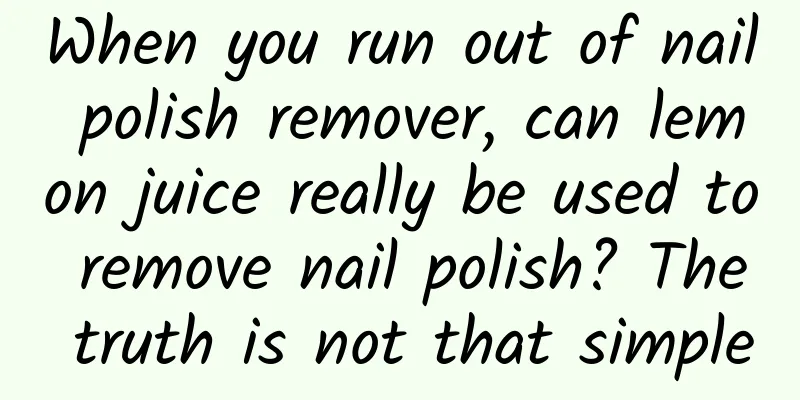When you run out of nail polish remover, can lemon juice really be used to remove nail polish? The truth is not that simple

|
Everyone loves beauty, and now "manicure" has become one of the three must-haves for the Chinese New Year. However, nails grow at a rate of about 0.1 mm per day, so how to scientifically remove nail art to avoid secondary damage to the nails is worth paying attention to. Copyright images in the gallery. Reprinting and using them may lead to copyright disputes. Nail polish, top-sealing glue and other products are used in the process of manicure. Nail polish is usually made of organic substances such as methacryloyl, ethyl ethyl acrylate, methyl benzoate, etc. mixed with pigments, while the glue used in manicure is composed of phenol formaldehyde, benzoyl peroxide and other substances. How to remove nail polish? Manicure adds color to our daily life, but as nails continue to grow, we need to replace or remove old manicures. Manicure removal is a process involving chemical and physical methods, designed to remove nail polish, glue and other substances on the nails while minimizing damage to the nails themselves. 1 Using nail polish remover The most common method of removing nail polish is to use nail polish remover, such as nail polish remover, nail polish remover water or nail polish remover cream. These products mainly contain ingredients such as acetone, propanol, acetone acetate, glycerin and citric acid, which can soften and dissolve nail polish. When using, first soak a cotton ball in nail polish remover, press it lightly on the nail, and wait for a few minutes for the nail polish to soften. Afterwards, you can use nail tools such as nail clippers or files to scrape off the surface of the nail polish, and then gently wipe it with a cotton ball soaked in nail polish remover until it is removed. Nail polish removers can be harmful to your nails. Common nail polish removers contain acetone, which can cause dryness to your nails and surrounding skin. Long-term or frequent use of nail polish removers containing strong solvents, especially those containing acetone, can cause your nails to become brittle, delaminate, or break. 2 Physical nail removal Physical methods, such as using a nail grinder or nail file to directly remove nail polish, can quickly remove nail polish, but this method can easily damage the surface of the nails and may cause the nails to become thinner or damaged , so it is not recommended for frequent use. Copyright images in the gallery. Reprinting and using them may lead to copyright disputes. 3 Natural nail polish removal method: Is lemon juice effective in removing nail polish? There’s a widespread belief on the internet that lemon juice is a perfect substitute if you’ve run out of nail polish remover at home. It’s said that “lemons are rich in citric acid, which has significant cleaning and degreasing properties, and can soften nail polish, making it easier to remove nail polish.” Is this really true? In reality, the situation may not be that simple. Although lemon juice does contain a large amount of citric acid, using it directly to remove nail polish may have very limited effect. With this in mind, if nail polish materials are so easily affected by citric acid, then nail polish will also be easily damaged when exposed to citric acid-rich liquids such as lemon juice, kiwi juice or orange juice on a daily basis. Copyright images in the gallery. Reprinting and using them may lead to copyright disputes. Lemon juice is thought to help remove nail polish, a belief that may also be partly due to the limonene component of lemon peels. Limonene is a known effective organic solvent that is widely used in industrial production, such as as a solvent for paints, resins and inks. Its low toxicity and environmentally friendly properties make it an ideal choice to replace traditional chemical solvents. However, it is true that limonene is a solvent, but the little bit of limonene contained in lemon is useless for removing nail polish. How to care for your nails after removing nail polish Keep your nails healthy It is important to take care of your nails after you remove them. Here are some tips for taking care of your nails to ensure they are healthy and strong: 1 Keep your nails clean After removing your nails, you should wash your nails with a mild cleanser and warm water to ensure that any remaining polish and chemicals are completely removed to avoid irritation and infection. 2 Nourishing and moisturizing Applying nail polish and nail cream to moisturize and protect your nails can help prevent them from becoming dry and brittle. These products can provide necessary moisture and nutrients to the nails and surrounding skin, enhancing their elasticity and toughness. 3 Balanced nutrition A balanced diet is important for nail health. Make sure your diet includes enough protein, vitamins (such as vitamins A, C, and E), and minerals (such as zinc and iron), which are key nutrients needed for nail growth and maintenance. 4 Avoid improper use of nails Avoid using your nails for inappropriate activities, such as digging or prying, which can damage or break your nails. Keep your nails clean. In short, you can effectively maintain the health of your nails by keeping them clean, nourished, avoiding improper use, and ensuring a balanced diet. If you encounter nail problems such as color changes, brittleness, breakage or shedding, you should seek advice and treatment from a professional doctor or nail technician in time. Do makeup removers have an impact on the skin? After talking about manicure, let's talk about makeup. Makeup is an indispensable part of sisters' daily life, and the makeup removal step that follows is equally important. Common makeup removal products include makeup remover water, makeup remover oil and makeup remover cream. **Their working principle is mainly based on the chemical law of "like dissolves like", **that is, using the ingredients in the makeup remover product to dissolve the cosmetics to achieve the purpose of cleaning the skin. Makeup removers usually consist of oils, emulsifiers, moisturizers, and preservatives. Although these ingredients are necessary for effective makeup removal, frequent use or product residue may cause damage to the skin. Irritation from chemical ingredients may cause dryness, sensitivity, or allergic reactions to the skin. At the same time, makeup removers containing oily ingredients can sometimes cause pores to become clogged, which can lead to breakouts and blackheads. In order to protect the skin, it is recommended to choose a mild makeup remover and use it in moderation. After removing makeup, the skin should be cleansed thoroughly to ensure that the residue of the makeup remover is minimized, thereby reducing the potential impact on the skin. After removing makeup and cleaning the skin, subsequent skin care should be carried out in a timely manner, such as using moisturizing and repairing skin care products. If you experience skin discomfort after using a makeup remover, such as redness, itching, or other allergic symptoms, it is recommended to stop using it immediately and seek professional medical advice and advice. Such steps will help ensure skin health and reduce the negative effects that may be caused by the makeup removal process. When sisters are enjoying the brilliance brought to you by manicures or makeup, they must also remember to remove manicures and makeup scientifically and reasonably, giving nails and skin proper rest and breathing space to make beauty more lasting! References [1] Hu Xiaoyu, Liu Liu, Cao Dongdong, et al. Detection and analysis of volatile components of 28 nail products in Beijing[J]. Journal of Health Research, 2018, 47(2): 325-329. [2] Jiang Hong, Xu Yingjian, Wang Jinghan, et al. Identification of nail polish types by high performance liquid chromatography [J]. Criminal Technology, 2011, (3): 3. [3] Xia Junpeng, Wu Fei, Shao Aimei, et al. Determination of 17 volatile organic solvents in nail polish by gas chromatography-mass spectrometry[J]. Journal article, 2013. [4] Chen Xiaoyu, Li Guowei, Jin Min. A brief discussion on the research progress of makeup remover products[J]. Journal of Daily Chemicals, 2023, 46(3):48-52. [5] Schoon, Douglas D. "Nail structure and product chemistry." (No Title) (2005). [6] Baran, Robert, and Howard Maibach. Textbook of cosmetic Dermatology. CRC Press, 2010. [7]Baran, Robert. "Nail cosmetics: allergies and irritations." American Journal of Clinical Dermatology 3 (2002): 547-555. Planning and production Author: Denovo Science Team Review | Feng Jun, deputy chief physician of the Dermatology Department of Sinopharm Tongmei General Hospital Planning丨Ding Zong Editor: Ding Zong Proofread by Xu Lailinlin The cover image and the images in this article are from the copyright library Reprinting may lead to copyright disputes |
>>: God Particle: Exploring the Mysterious Origin of Mass
Recommend
Scientists discovered a galaxy with a huge hole. Could it be the remains of a violent "war"?
All current scientific observations and discoveri...
How long will it take for VR to enter its spring?
[[176552]] Overall, the development of the VR sec...
Why is there still formaldehyde in a newly renovated house one year later? Beware of these "hidden corners"
After finishing the renovation of their new house...
Are we still unaware of the radiation we are exposed to? Can we still eat food contaminated by nuclear weapons?
The theme of the popular science comics is derive...
Mastering "user thinking" is a necessary quality for Internet product operators
Today is an era where users and traffic are king....
How to increase website traffic? How to increase website traffic?
Increasing website traffic is the dream of every ...
Don’t you guys like to watch ads? Video sites have a new solution
Imagine that you no longer have to wait for 40 se...
There was no college entrance examination in ancient times. Let’s talk about the history of the imperial examination for selecting talents in ancient times.
When it comes to "college entrance examinati...
This National Day, the Xinjiang lamb skewers you eat may contain Zhejiang technology
As the National Day is approaching, more than 2,0...
When will the plum rain season begin in Hangzhou, Zhejiang in 2022? When exactly does the plum blossom season end? Attached is the latest rainy season time
Recently, not only has the rainfall in southern m...
Talk about the hidden rules of App operation
First, let’s deconstruct the position of App Oper...
How to use Tik Tok more efficiently? Master these five vertical screen thinking!
Why is it that when Chengdu sweet girl says “I th...
The core ideas and 14 practical methods of Weibo promotion
Weibo promotion uses Weibo as a promotion platfor...
Tips for creating landing pages for advertising!
This article will share with you the techniques f...
Don't play with your phone while it's charging! If you want your phone's battery to last longer, pay attention to these points
Is the battery life of your mobile phone getting ...









